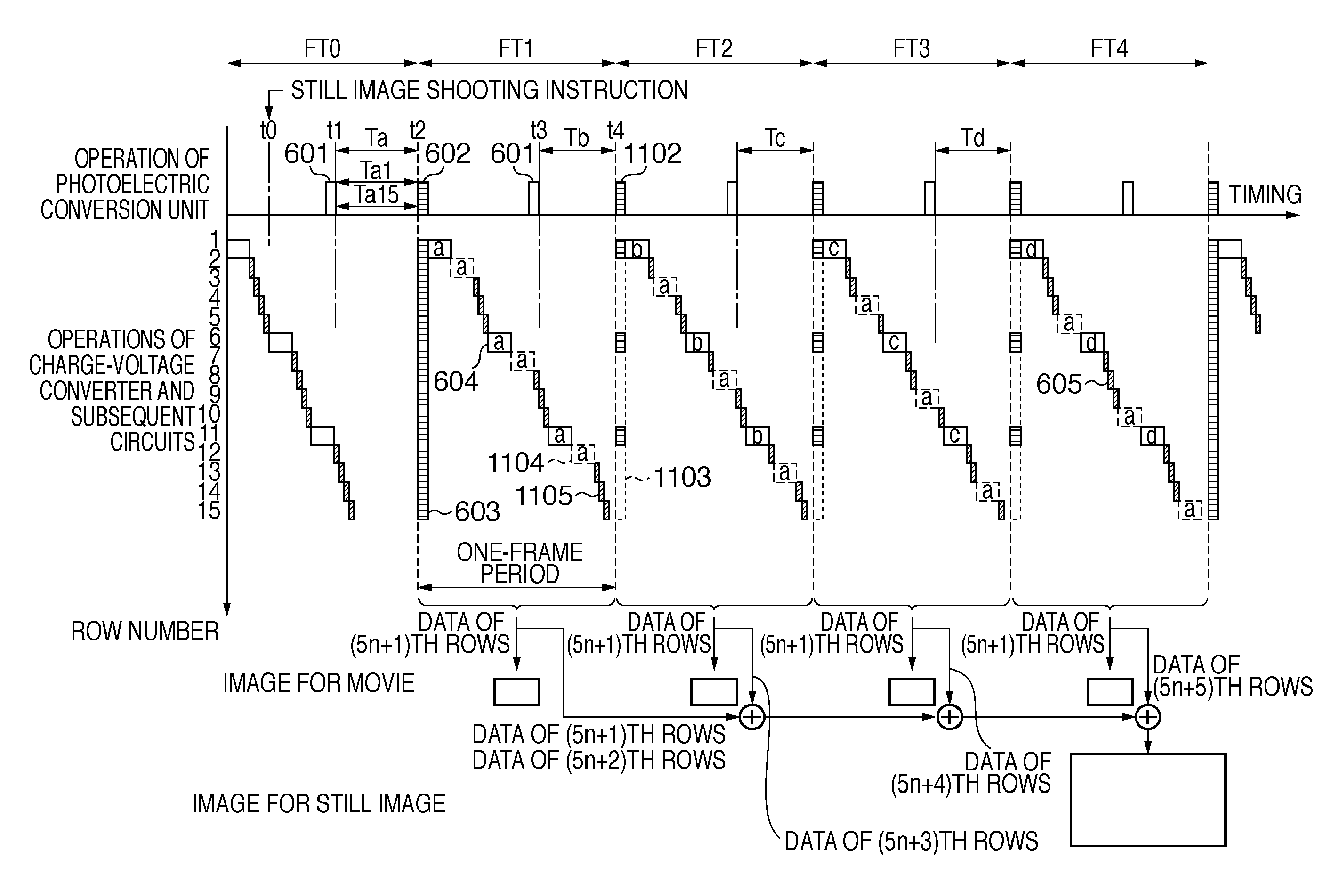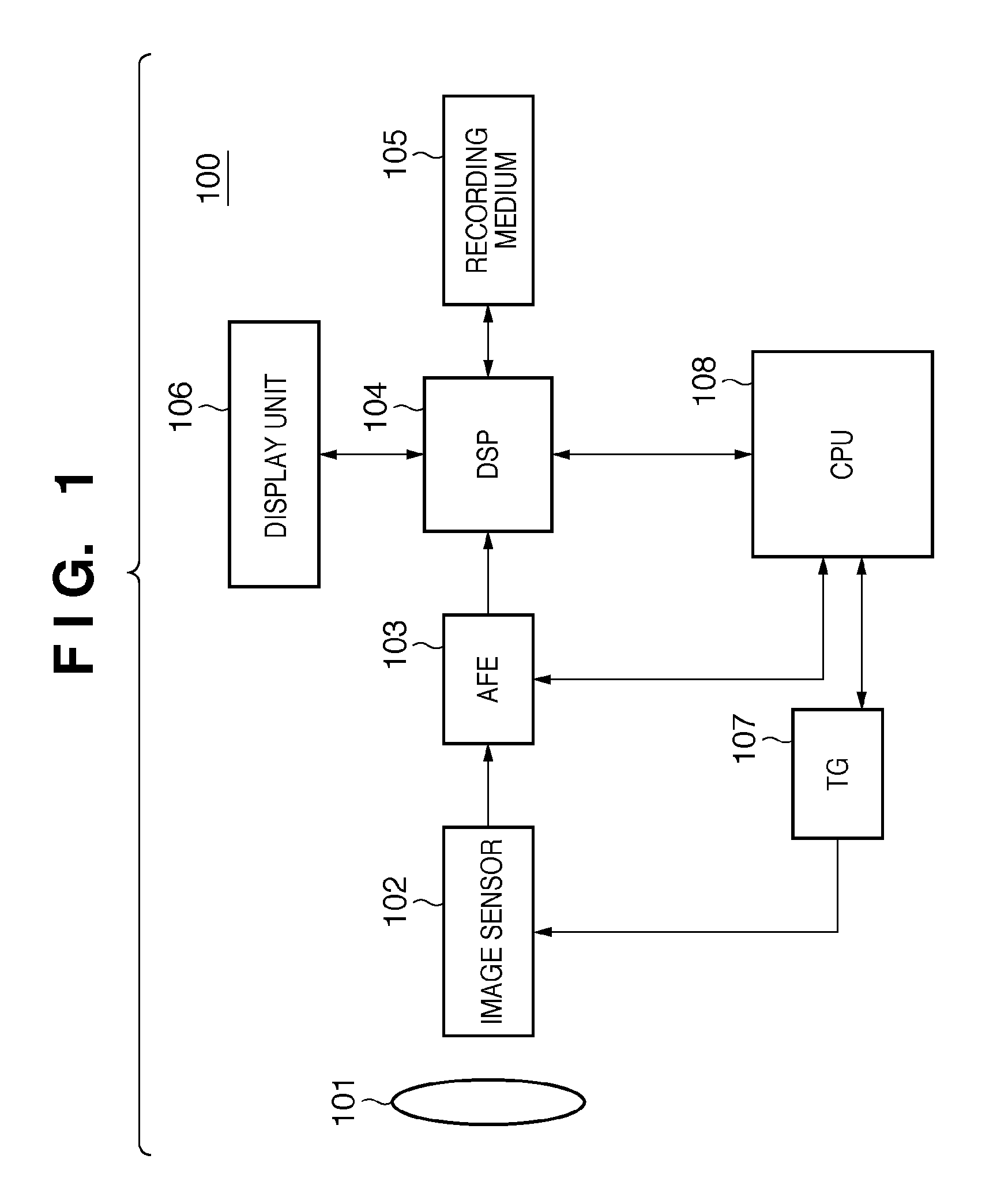Image sensing apparatus
a technology of image sensing and image data, which is applied in the field of image sensing apparatus, can solve the problems of poor spatial resolution of still image data generated from still image shooting, poor temporal resolution of still image obtained from movie data, and poor spatial resolution of still image data, so as to improve the simultaneity of accumulation, reduce frame rate, and high spatial resolution
- Summary
- Abstract
- Description
- Claims
- Application Information
AI Technical Summary
Benefits of technology
Problems solved by technology
Method used
Image
Examples
first embodiment
[0055]The image sensing apparatus 100 employs a simultaneous electronic shutter function as an electronic shutter function. The image sensing apparatus 100 includes the following constituent elements.
[0056]An imaging lens 101 forms the optical image of an object on the image sensing surface (pixel array) of an image sensor 102.
[0057]The image sensor 102 converts an optical image formed on the image sensing surface (pixel array) into an image signal. The image sensor 102 reads out the converted image signal from the pixel array, and outputs it. The image sensor 102 is, e.g., a CMOS image sensor.
[0058]A CPU 108 receives an instruction from the user via an operation member (not shown) such as a shutter button, and controls an AFE (Analog Front End) 103, DSP (Digital Signal Processor) 104, and TG (Timing Generator) 107 in accordance with the received instruction. The AFE 103 receives an analog image signal output from the image sensor 102. The AFE 103 performs analog signal processing ...
third embodiment
[0158]The image sensing apparatus according to the present invention employs a slit rolling electronic shutter function as an electronic shutter function. An image sensing apparatus 100 includes the following constituent elements.
[0159]As shown in FIG. 17, each of pixels P11i to P44i in a pixel array PA of an image sensor 102 does not include the first reset unit 202. FIG. 17 is a circuit diagram of the structure of the pixel P11i in the image sensing apparatus according to the third embodiment of the present invention.
[0160]When resetting a photoelectric conversion unit 201 in the pixel P11i, both signals “tx1” and “resf1” change to an active level at once to turn on both a transfer unit 203 and second reset unit 206. Then, both of remaining charges in the photoelectric conversion unit 201 and remaining charges in the charge-voltage conversion converter 204 are exhausted to the power supply via the transfer unit 203 and second reset unit 206. FIG. 17 is a circuit diagram of the str...
fourth embodiment
[0219]FIG. 31 schematically shows an operation in the movie shooting mode in the In FIG. 31, the abscissa axis represents the timing. An upper part of the ordinate axis represents the position of a pixel row associated with a signal readout operation from a photoelectric conversion unit 201 up to the memory 2903. A lower part of the ordinate axis represents a signal output operation from the memory 2903.
[0220]As shown in FIG. 31, a first accumulation period group T2a is a group of first accumulation periods T2a1 to T2a15 which partially overlap each other by the same duration between at least two adjacent rows. More specifically, the completion timing of a reset operation 3101 is delayed from that of the reset operation of an immediately preceding row by the timing taken for a first readout operation 3102 of the immediately preceding row. This makes the first accumulation periods T2a1 to T2a15 in the first accumulation period group T2a equal to each other. The delay is a constant t...
PUM
 Login to View More
Login to View More Abstract
Description
Claims
Application Information
 Login to View More
Login to View More - R&D
- Intellectual Property
- Life Sciences
- Materials
- Tech Scout
- Unparalleled Data Quality
- Higher Quality Content
- 60% Fewer Hallucinations
Browse by: Latest US Patents, China's latest patents, Technical Efficacy Thesaurus, Application Domain, Technology Topic, Popular Technical Reports.
© 2025 PatSnap. All rights reserved.Legal|Privacy policy|Modern Slavery Act Transparency Statement|Sitemap|About US| Contact US: help@patsnap.com



